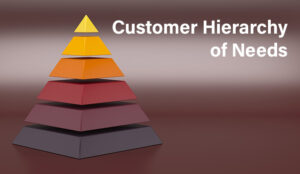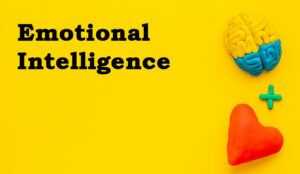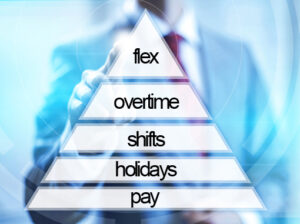Is there a Maslow hierarchy of needs in customer service? You’re probably aware of Maslow’s hierarchy of basic human needs: shelter, food, warmth…..wifi.
Editor Jonty posed the question: is there an equivalent hierarchy for customer needs?
I love a good question like this with no right answers, especially one that causes a good argument! It just so happens we have a long-running internal debate about such a hierarchy which I’ll share.
First what might the ‘needs’ be? Then, what sequence do they fall into, if there is a customer hierarchy of needs?
Basic Needs in the Customer Hierarchy of Needs
Of course there are the most basic customer needs – getting an answer to the question, a resolution to the problem, a successfully concluded transaction. The confidence it’s been done correctly and completely. “Did you get what you wanted?”
You might think of this most basic solution in the context of “first contact resolution”. So a quick reminder to start with zero contact resolution, not first contact. The avoidance of the need to do anything first, the easy resolution for yourself second. Only if these steps fail, do we need contact service at all.
We should also highlight a pandemic or phishing-driven “You keep me safe”. The equivalent to “safety and security” in Maslow’s hierarchy. Can you think of others?
Emotional Needs in the Customer Hierarchy of Needs
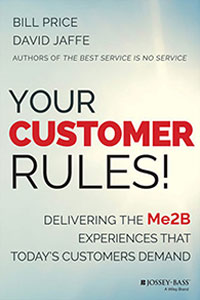
But what about customers’ emotional needs?
In research for our second book “Your Customers Rule – Delivering the Me2B experiences that customers demand” by colleagues David Jaffe & Bill Price, beyond the most basic needs, seven groups of emotional needs were identified.
Expressed in the customers’ own words, they cover some 49 sub-expressions of need.
The seven are (alphabetically):
- “You give me choices”
- “You know me, you remember me”
- “You make me better and (able to) do more”
- “You make it easy for me”
- “You surprise me with stuff I can’t imagine”
- “You trust me”
- “You value me and listen to me”.
Me2B (Me to Business) thinking, the inverse of B2C (Business to Consumer) or B2B (Business to Business) thinking, is how do I the customer think about how my ‘suppliers’ meet my needs. Hence the language and specific words.
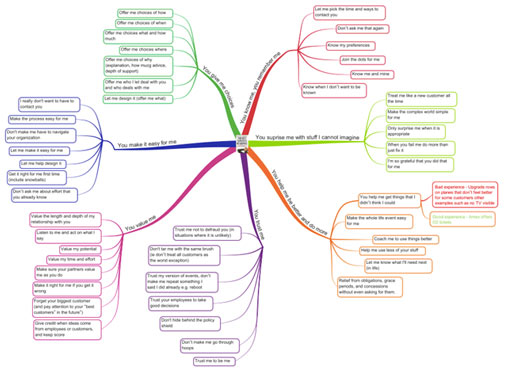
Simon Roncoroni had shown a very similar set of needs back in 2002 in work with HSBC. In fact, you’ll find a number of sources with similar mental models. That’s because the human needs are fairly universal.
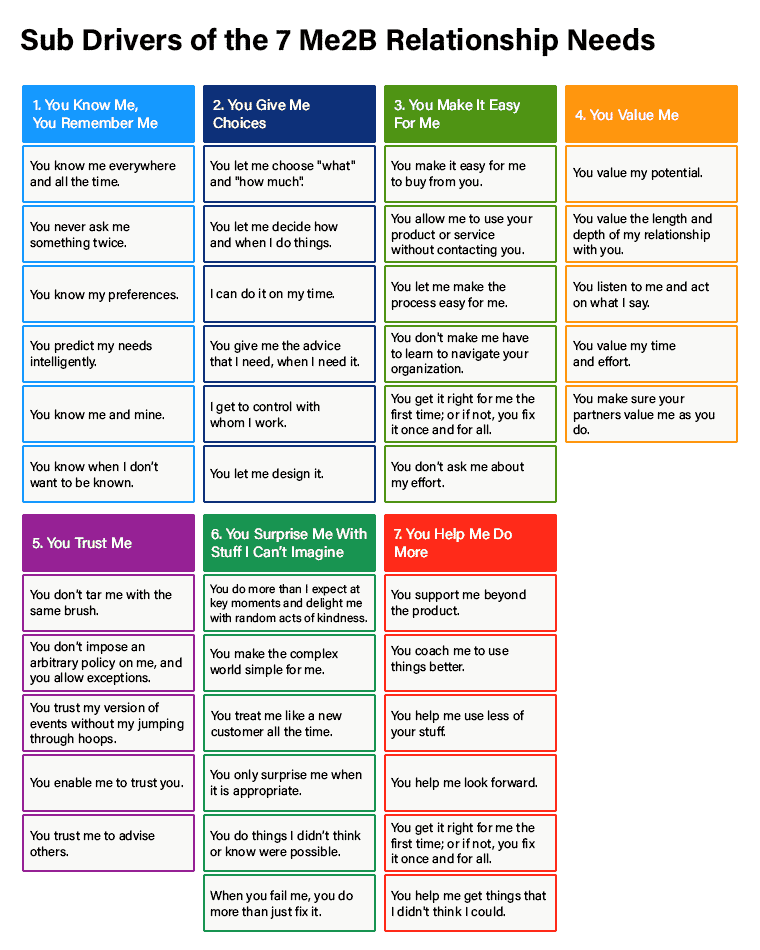
Try This Test
Give yourself examples of how your partner or family member meets these seven needs. And the emotional feeling it generates. Then try your favourite and your nightmare company.
For example, how does your partner meet these needs and what’s the emotional response created? How do they value you and listen to you? How do they make it easy for you?
Try This Test on Your Favourite Suppliers
What about your favourite or least favourite suppliers, i.e. companies. A current pet hate is Paypal, who are doing really well on only one of the needs – they never cease to surprise me with their attitude and capability to prevent me using my money!! The other six needs they fail at miserably.
The seven needs are a way of analysing a relationship.
So if we accept that these seven groups of needs form a basis, then do they escalate and how? In the book they are indeed shown as a triangle in the same way as Maslow’s hierarchy is usually shown. At the time it created debate amongst our colleagues. Is it a hierarchy or not, in the way that Maslow clearly moves up an escalator?
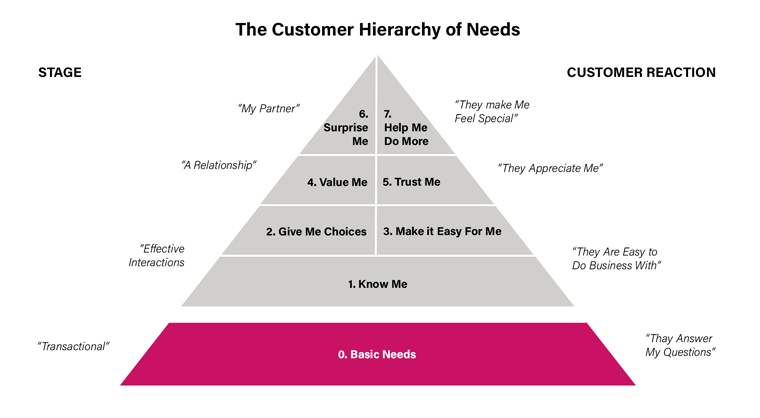
Diagram from “Your Customers Rule – Delivering the Me2B experiences that customers demand” by colleagues David Jaffe & Bill Price, with Basic Needs Added
In the book [see triangle] they are described as moving from effective interactions to a relationship, moving up to partnership, in turn causing reactions: easy to do business with, appreciation and finally feeling special.
It’s quite possible to see things this way, but I feel it’s somewhat linear thinking in practice. After many discussions amongst our client groups, to me there was no correct hierarchy of needs. Just practical ways to think about and use the mental model which the seven needs provides.
Two questions helped me use the hierarchy of needs in practice.
- How would you describe the brand’s expectations of the experiences a customer should have? – using the seven needs.
- How do customers, or their proxy, the frontline staff, see the gap in practical experiences compared to that expectation?
I find the analogy of a mixing desk with seven sliders more useful than a pyramid of seven building blocks in progressing this debate about the gap in expectations.
For example, if Easyjet isn’t aiming to be fully turned up on “You make it easy for me” then customers’ physical and emotional expectations will not be met. But where are they aiming to be on the other six needs? Not every brand is trying to max all seven needs.
Not every brand should know and remember you if it’s to be successful – anonymity is a benefit some customers want for some private interactions.
Worked Example of 7 Needs – Tesla
Not every brand is about maximum choice, e.g. Tesla limits choices for its and your benefit. Compare its Model 3 with a VW ID4 online and you’ll see the difference. 3 power specs, 5 colours, 2 interior colours, 2 wheel types. That’s about it. I still can’t work out the ID4 reasoning……let alone the options.
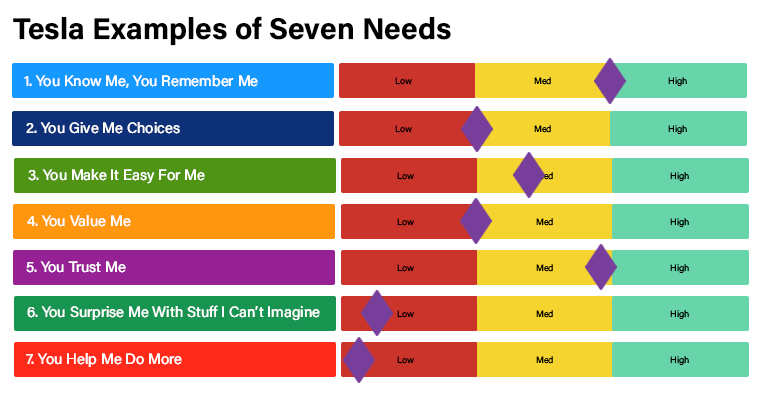
Taking Tesla as an example, let’s look at the 7 items. Let’s allocate them an ideal slider score for their brand aspiration (anyone from Tesla know the real answer?)
1. You Know Me, You Remember Me
High – Know me remember me: everything is done by you – the site, the geographical location and the company through your one account online/in the app. So that’s taken care of, whether pre-sale, using the car or the services. It’s removal of hassle.
2. You Give Me Choices
Low – Give me choices: see above
3. You Make It Easy For Me
High – Make it easy for me: everything is built into the app or the car. The UX of both is given detailed attention at every stage.
The charging network is a classic example of removing a perceived problem and providing a competitive leap. Test drives are simply booked online. There are no discounts to haggle over. The buying process is transparent. The service engineer will drive to you rather than you to them.
4. You Value Me
Medium – Value me: the community of Tesla fans and both the new and used prices of the vehicles testify to the reputation of the company.
Though it has to be said, service has been up and down at times. Elon Musk has been quoted talking Best Service Is No Service language – engineer out things that go wrong, engineer out any unnecessary complexity so service problems don’t occur.
Constant over-the-air updates provide the means to continually improve the car and the experience of it.
5. You Trust Me
High – Trust me: attitudes are those of a tech company not a car company. As well they might be, given their valuation is more than the next nine car companies put together. Simple things like walking away from or up to the car without needing to do anything to lock or unlock the car.
Grown-up conversations to help you buy or not. Easy, low refundable deposit. No hard sell of financial services, you can do that yourself. Immediate headlines but also attention should anything step out of line.
6. You Surprise Me With Stuff I Can’t Imagine
Low – Surprise me – there are so many examples born of Tesla’s ethnographic understanding of how users use their cars. A great example is “dog mode”. You just press it when charging and walk away. The internal alarm is switched off, the aircon is left on and a big screen says “My owner will be back soon. Don’t worry, the a/c is on and it’s 20oC.”
7. You Help Me Do More
Low – Help me do more: leading in autonomous self-driving technology for a start. Their journey planner with charging built in is first class.
Conclusion

Peter Massey
So there may be no “right” answer to whether the seven needs fall easily into a customer hierarchy of needs. For some customers and some things they need, then basics first.
For others, it’s more complex. But the “right” questions are ‘what problem are you trying to solve?’ and ‘is a hierarchy of blocks or a mixer analogy more helpful in getting you some practical agreement and progress?’
Written by: Peter Massey at Budd
To discover more insights on understanding your customers and their needs, read these articles next:
- Understanding Your Customers: 5 Practical Techniques
- Really Understand Why Your Customers Are Contacting You
- Harnessing the Power of ‘What Our Customers Are Saying’
Author: Peter Massey
Published On: 7th Feb 2022 - Last modified: 9th Nov 2023
Read more about - Customer Service Strategy, Customer Satisfaction (CSAT), Customer Service, Peter Massey



